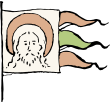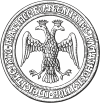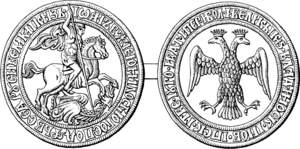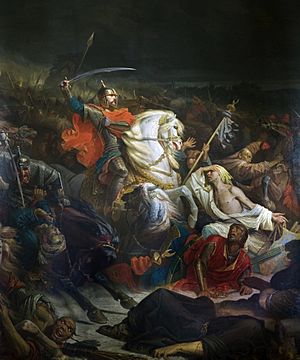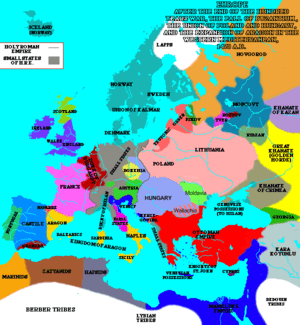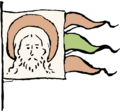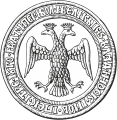Grand Duchy of Moscow facts for kids
Quick facts for kids
Grand Duchy of Moscow
Principality of Moscow
|
|||||||||||||||||||||
|---|---|---|---|---|---|---|---|---|---|---|---|---|---|---|---|---|---|---|---|---|---|
| 1263–1547 | |||||||||||||||||||||
Double-headed eagle on the seal of Ivan III
|
|||||||||||||||||||||

Territorial expansion between 1300 and 1547
|
|||||||||||||||||||||
| Status |
|
||||||||||||||||||||
| Capital | Moscow | ||||||||||||||||||||
| Common languages | Old East Slavic, Russian | ||||||||||||||||||||
| Religion | Russian Orthodox (official) | ||||||||||||||||||||
| Demonym(s) | Muscovite | ||||||||||||||||||||
| Government | Absolute monarchy | ||||||||||||||||||||
| Grand Prince | |||||||||||||||||||||
|
• 1263–1303
|
Daniel (first) | ||||||||||||||||||||
|
• 1533–1547
|
Ivan IV (last) | ||||||||||||||||||||
| Legislature | Veche | ||||||||||||||||||||
| History | |||||||||||||||||||||
|
• Established
|
14 November 1263 | ||||||||||||||||||||
| 16 January 1547 | |||||||||||||||||||||
| Area | |||||||||||||||||||||
| 1505 | 2,500,000 km2 (970,000 sq mi) | ||||||||||||||||||||
| Currency | ruble, denga | ||||||||||||||||||||
|
|||||||||||||||||||||
The Grand Duchy of Moscow (also known as the Principality of Moscow or simply Muscovy) was a powerful state in Eastern Europe during the Late Middle Ages. It was centered around the city of Moscow. This principality grew over time and eventually became the Tsardom of Russia in the early modern period.
The rulers of Moscow were descendants of Daniel of Moscow, the first prince. The state began in 1263 when Daniel inherited the territory from his father, Alexander Nevsky. At first, Muscovy was a vassal state of the Golden Horde. This meant they had to pay tribute and provide soldiers to the Golden Horde's rulers, called khans.
Over time, Moscow became stronger than other Russian principalities and absorbed them. A key moment was the Great Stand on the Ugra River in 1480. This event marked the end of the Golden Horde's control over Russia. Before this, there were many uprisings and successful battles against the Mongols. One famous example is the Battle of Kulikovo in 1380, led by Dmitry Donskoy.
Ivan III (also known as "the Great") made the state even stronger during his 43-year rule. He fought against the Grand Duchy of Lithuania and by 1503, he had made his territory three times larger. Ivan's son, Vasili III, also had military success. He took Smolensk from Lithuania in 1512. Vasili's son, Ivan IV ("the Terrible"), was crowned tsar in 1547. This marked the official start of the Tsardom of Russia.
Contents
What Was Muscovy?
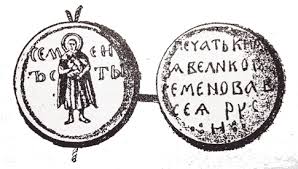
The Grand Duchy of Moscow was known by several names. These include the Principality of Moscow, Muscovy, Muscovite Rus', or Muscovite Russia. The English names "Moscow" and "Muscovy" come from the Latin word Moscovia.
Like many states in the Middle Ages, Muscovy didn't have one official name. Instead, its rulers used different titles. Common short titles were "The Prince of Moscow" or "The Sovereign of Moscow." After Moscow joined with the Principality of Vladimir in the mid-1300s, the Moscow prince sometimes called himself "the Prince of Vladimir and Moscow." This was because Vladimir was older and more respected.
To show their power over other Russian princes, Muscovite princes also called themselves "Grand Princes." As their territory grew, their full titles became very long. However, in daily documents and on seals, they used shorter names. These included "the Grand Prince of all Rus'" or "the Sovereign of all Rus'." The Golden Horde even gave Ivan Kalita the title of "All Russia."
Since the 1300s, Moscow princes added "of all Rus'" to their titles. This was similar to the title used by the head of the Russian Orthodox Church. This phrase, "of all Rus'," started as an honorable title. But under Ivan III, it became a political claim. It meant Moscow wanted to rule all the lands of the old Kievan Rus'.
This claim caused problems with the Grand Duchy of Lithuania. Lithuania controlled a large western part of the old Rus' lands. Because of Polish-Lithuanian influence, Western Europe started calling the Moscow state "Muscovy." This name stuck around until the early 1700s and is still used in history books today.
How Muscovy Began
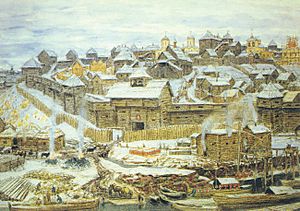
When the Mongols invaded in the 1200s, Moscow was just a small town. It was part of the principality of Vladimir-Suzdal. Even though the Mongols burned Moscow in 1238, its location helped protect it. Being remote and forested offered some safety from Mongol attacks. Rivers also gave access to important seas and regions. People in Moscow were able to keep their Slavic and Orthodox traditions under Mongol rule.
The growth of Moscow was also due to its clever princes. They expanded its borders and turned a small area into the largest state in Europe by the 1500s. The first ruler of Moscow was Daniel I (died 1303). He was the youngest son of Alexander Nevsky. Daniel started expanding his principality by taking Kolomna and securing Pereslavl-Zalessky.
Daniel's son, Yury (ruled 1303–1325), controlled the entire area around the Moskva River. He also expanded west by conquering Mozhaisk. Yury made an alliance with Uzbeg Khan of the Golden Horde and married the khan's sister. This alliance allowed Yury to become the Grand Duke of Vladimir-Suzdal. This position gave him influence over the Novgorod Republic.
By the early 1300s, Moscow became the most important town in Vladimir-Suzdal. This was partly because the Mongol khan favored it. Also, the head of the Russian Orthodox Church, the Metropolitan, moved his main office to Moscow in 1325. This greatly increased Moscow's importance.
Yury's successor, Ivan I (ruled 1325–1340), kept the title of grand duke. He worked closely with the Mongols, collecting tribute and taxes for them. This helped Ivan gain power over Moscow's main rival, the city of Tver. Tver rebelled against the Golden Horde in 1327, but Moscow helped put down the uprising. Ivan was nicknamed "Kalita," meaning "moneybag." He used his wealth to buy land and build stone churches in the Moscow Kremlin.
Dmitry Donskoy and the Fight for Freedom
Ivan's successors continued to "gather the Russian lands." This meant they kept adding more people and wealth to their rule. Their expansion led to conflicts with the growing Grand Duchy of Lithuania. Lithuania's people were mostly East Slavic and Orthodox, just like Muscovy's. Grand Duke Algirdas of Lithuania attacked Moscow three times but could not capture it.
In the 1350s, the Black Death plague hit the country and the royal family. Dmitry Ivanovich was only nine years old when his parents died. The title of Grand Duke went to a distant relative. Surrounded by Lithuanians and Muslim nomads, Dmitry formed an alliance with the Rus' Orthodox Church. The Church's influence grew thanks to the reforms of St. Sergius of Radonezh.
Dmitry, guided by Metropolitan Alexis, became a champion of the Orthodox faith. He united the different Russian principalities to fight against the Golden Horde. He challenged the Khan's power and defeated his commander Mamai in the famous Battle of Kulikovo in 1380. However, this victory didn't immediately free Russia. In 1382, Tokhtamysh sacked Moscow, killing 24,000 people, to show the Horde's power.
Despite this, Dmitry became a national hero. The memory of the Battle of Kulikovo inspired Russians to believe they could end Tatar rule. In 1389, Dmitry passed the throne to his son Vasily I without asking for the Khan's permission. This was a big step towards independence.
Vasily I and Vasily II: Growth and Conflict
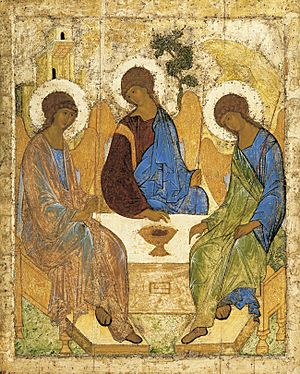
Vasily I (1389–1425) followed his father's policies. After the Golden Horde was attacked by Tamerlane, Vasily stopped paying tribute. But he had to be more careful after Edigu attacked Moscow in 1408. Vasily was married to the daughter of Vytautas, the Grand Duke of Lithuania. He tried to avoid open conflict with his powerful father-in-law, even when Lithuania took Smolensk. Vasily's long reign saw Moscow expand east and north, adding Nizhny Novgorod, Suzdal, Vologda, Veliky Ustyug, and Perm.
The reforms of St. Sergius led to a cultural rebirth. This was seen in the beautiful icons and frescoes by the monk Andrei Rublev. Many monasteries were founded by Sergius's followers in distant places. These monasteries were not just religious centers; they owned a lot of land and controlled the local economy. They also helped spread Moscow's influence to nearby principalities. Another reason for Moscow's growth was its stable line of rulers. Each prince was succeeded by his son, while rival principalities often had internal conflicts and broke into smaller states.
The situation changed when Vasily I's son, Vasily II (ruled 1425–62), became ruler. His uncle, Yuri of Zvenigorod, claimed the throne. This started a bitter family conflict that lasted for much of Vasily II's reign. After Yuri died, his sons continued the "Great Feudal War" into the 1450s. Vasily II was sometimes driven out of Moscow, taken prisoner, and even blinded in 1446. But he eventually defeated his enemies and passed the throne to his son. During his rule, a Russian bishop was chosen as Metropolitan of Moscow. This was a declaration of independence for the Russian Orthodox Church from the Patriarch of Constantinople.
Ivan III: Uniting the Lands
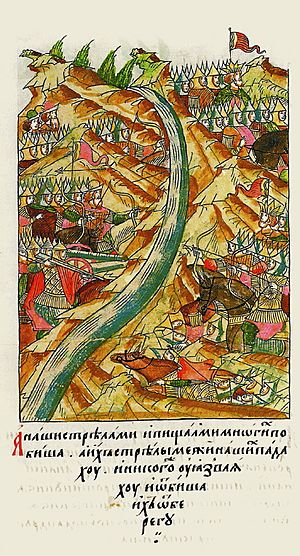
As the Grand Duchy expanded in the 1300s and 1400s, it also became stronger internally. By the 1400s, Moscow's rulers believed they owned all the lands of the old Kievan Rus'. Many semi-independent princes still ruled their own areas. But Ivan III (the Great; ruled 1462–1505) made these lesser princes accept the Grand Prince of Moscow as their unquestioned ruler. This meant Moscow controlled their military, laws, and foreign relations.
Moscow gained full independence from the Tatar Golden Horde in 1480. This happened after their defeat in the Great Stand on the Ugra River. By the early 1500s, almost all these lands were united under Moscow. This included the Novgorod Republic (taken in 1478) and the Principality of Tver (taken in 1485). Ivan also gained the important Principality of Ryazan through inheritance. The princes of Rostov and Yaroslavl also submitted to him. The city of Pskov remained independent for a while, but Ivan's son, Vasili III (ruled 1505–33), later conquered it.
After uniting the core of Russia, Ivan III was the first Moscow ruler to use the titles of tsar and "Ruler of all Rus'." Ivan also competed with his rival, the Grand Duchy of Lithuania. He wanted control over former principalities of Kievan Rus' in the Dnieper and Donets river basins. Through princes switching sides, border fights, and long wars, Ivan III pushed westward. The Moscow state tripled in size under his rule.
The reign of the Tsars officially began with Ivan the Terrible. He was the first monarch to be crowned Tsar of Russia. But in reality, the centralization of the state (known as "the gathering of the Russian lands") was completed by Ivan III.
The Royal Court
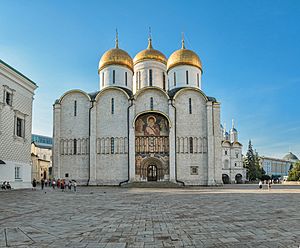
The court of the Moscow princes mixed traditions from Kievan Rus' with new customs from the Byzantine Empire and the Golden Horde. Old Russian offices, like the tysyatsky (military leader) and veche (assembly), were slowly removed. This helped the ruling prince gain more power. A new system called mestnichestvo decided a nobleman's rank and job. This was based on the rank of his ancestors and family members. The highest group of nobles were the boyars. They fell into three main types:
- Rurikid princes from towns like Suzdal and Rostov. They moved to Moscow after their lands became part of the Duchy (e.g., Shuisky family).
- Foreign princes from Lithuania and the Golden Horde. They claimed to be descendants of Gediminas or Genghis Khan (e.g., Galitzine family).
- Old Moscow noble families who had served the Grand Dukes since the 1300s (e.g., Romanov family).
Rurikid and Gediminid boyars felt they were related to the Grand Prince and almost equal to him. During times of trouble, like when Ivan IV was a child, the boyars could be a threat to the throne. Ivan the Terrible's oprichnina policy was an early example of a ruler dealing with the boyars.
During these conflicts, rulers like Ivan and Boris Godunov felt they needed to balance the power of the boyars. They created a new type of nobility. These new nobles were chosen based on their loyalty to the tsar and their service, not just their family history. These new nobles were called dvoryans. The name comes from the Russian word dvor, meaning "tsar's court."
Muscovy's Relationship with the Golden Horde
Muscovy's relationship with the Golden Horde was complicated. In the early 1200s, Moscow gained support from a Mongol leader named Nogai Khan. This helped them against other principalities. After the Golden Horde became united again in the early 1300s, Moscow generally had the khans' favor until 1317. This good relationship helped Moscow grow economically and politically.
Later, the Golden Horde tried to take away Moscow's status as grand dukes of Vladimir. But these attempts failed, especially as the Khanate fell into internal wars. Even a powerful khan like Mamai couldn't stop Moscow's rise. Eventually, the Golden Horde had no choice but to accept Moscow's power over northern and eastern Russian lands. The Mongol idea of breaking up large powers into smaller ones failed.
Even though Moscow recognized the khans as rulers in the early years of Mongol rule, they often resisted. They refused to accept the Horde's control in certain periods, even when the Golden Horde was strong. The Horde's power over Moscow was greatly reduced during the reign of Dmitry Donskoy. He made the Grand Duchy of Vladimir a hereditary possession of Moscow's princes. This meant the Horde could collect tribute but couldn't seriously affect Moscow's internal affairs.
Under Vasily II and Ivan III, the Grand Duchy of Moscow adopted the idea of a "tsardom" from the fallen Byzantine Empire. This idea meant they were independent rulers, not under the khan's control. They began to declare their independence in dealings with other countries. This process was completed by the time Ivan III ruled.
Why Muscovy Was Important
The modern Russian state developed from Kievan Rus', through Vladimir-Suzdal, then the Grand Duchy of Moscow, and finally the Tsardom of Russia and the Russian Empire. The Moscow Duchy attracted people and wealth to northeastern Kievan Rus'. It created trade routes to the Baltic Sea, White Sea, Caspian Sea, and Siberia. It also built a very strong and autocratic (single-ruler) political system. The political traditions started in Muscovy had a huge impact on how Russian society developed in the future.
Society in Muscovy
- Structure
- The society had different groups of people.
- Class
- Boyars: High-ranking nobles.
- Knyaz: Princes or dukes.
- Kholop: Serfs or slaves.
- Smerd: Peasants.
- Posad people: Townspeople.
- Service class people (Sluzhilyye lyudi): People who served the state.
- Former people (Byvshiye lyudy): People who lost their social status.
- Izgoi: Outcasts or people without a fixed social place.
Culture in Muscovy
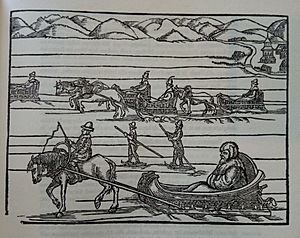
Muscovite Russia's culture was a mix of Slavic and Byzantine influences. In daily life, people in Muscovy strongly believed in the supernatural.
Images for kids
See also
 In Spanish: Principado de Moscú para niños
In Spanish: Principado de Moscú para niños
- Prince of Moscow
- Collector of Russian lands
- List of wars involving the Grand Duchy of Moscow
- Crimean–Nogai slave raids in Eastern Europe
- 15th–16th century Moscow–Constantinople schism
- List of tribes and states in Belarus, Russia and Ukraine
- Foreign policy of the Russian Empire


